TINY HOUSE SYSTEMS
 Lara Isaacson
Lara Isaacson

 Lara Isaacson
Lara Isaacson
One tiny hop at a time.
Often when trying to create a better future for ourselves and others, we settle for being less bad. This book is for those of you who want to live generously and move from having a less negative impact to a positive impact. This book is also for when you ‘went tiny’ or you ‘build tiny’ but still feel it is not enough for yourself or the world. Tiny House Systems will help empower your path.
Building for ‘tiny’ alone is missing the point. Building for a more equitable world and a thriving future is a goal that will create habitable home in communion with the people and environments around us. Whether you are an tiny house professional, enthusiast, or just want to see the world through a tiny house lens, together we will look at ‘tiny’ in the context of nested systems. These systems provide the framework for meaningful change in our individual and collective lives.
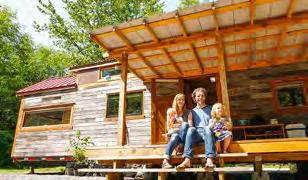
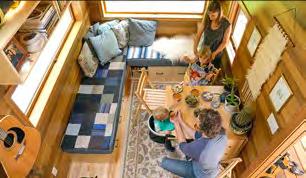
Apartment
Tiny House
Traditional house
Hobbit hole
Other
System Roof
Throughout Part One, we are going to build a tiny house metaphor to help guide our understanding of meaningful change. Don’t worry about absorbing it all now. Look for the little cream-colored boxes that will explain each building element as it is relevant. At the end of Part One, we will revisit the metaphor as a checklist for future projects.
Sizable Feedback
Windows of Transparency
Resilient Siding
Door to Community
Grateful Resting Porch
Ethical Pillar
Trailer Leverage
The explanation for each part of the Tiny House Model will be here.
What is your relationship to tiny houses?
I am tiny house obsessed! I am a tiny house dweller or builder I am new and curious

Let’s define what we mean by ‘tiny houses’ (for the purposes of this book, not to exclude anyone from the movement). Tiny houses are typically between 100-400 square feet homes that are often build on trailers in attempts to avoid ridged building codes or to fall under RV laws and/or to provide mobility.36, 43 Whether with a traditional looking frame or a modern twist, tiny houses have become increasingly popular in the United States and turned into a lifestyle movement: The Tiny House Movement.43
Tiny houses are often seen as a unit, separate and distinct from it’s context. But the people within tiny houses, near them, and those who build them, along with all the functions and ’rooms’ of the tiny house, come together to make a tiny system working together to create a home, a physical and mental safe, supportive space for people. Even the people within a tiny house (their bodies and interactions with each other) are also tiny systems.

“a group of interacting bodies under the influence of related forces…serving a common purpose”9
Communities can be defined in many ways.
What are 3 communities you belong to?
The most important parts of the tiny house system: the activity and energy operators. Since humans are can tack action and manipulate their environments, they are arguably the most crucial point in a tiny house system to consider. What motivates the tiny house dweller and builder to do tiny?
Tiny house builders, like other builders, want to build homes to make a living, but nothing in their job title requires a push towards systems thinking* or environmental considerations. Of course, many do consider the lowered resource use from less materials and less waste, but the traditional framing of many tiny houses indicates that the story of impact on people and the environment ends there. Many tiny houses use raw natural resources, plastics in the form of paints, counter tops, siding, and conventional fiberglass insulation. Though a tiny house offers the opportunity to build a fresh paradigm* with each material carefully considered from each aspect of it’s (product) lifecycle*. Nevertheless, tiny house builders are blazing the trail for a different way for thinking about new construction in the US. To give an idea of the possible aesthetics and paths for tiny house builders, here are a few beloved builders.
TumbleWeed Tiny House Company is one of the original tiny house builders and is now a certified ‘green RV’ manufacturer, demonstrating their sustainability efforts. (Some tiny houses are called RVs--Recreational Vehicles--in order to help make tiny homes a legal option, allowing them to fall under existing RV laws, rather than having to create a new tiny house law.)
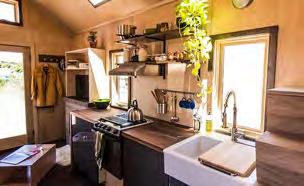

Tiny House Nation is a wholesome, corny reality TV show with two hosts—one a charming dad figure and the other a whiz with convertible furniture— and with every episode locked on a theme—from rock-climbing tiny to music studio.

Mustard Seed Tiny Homes is a hip small business, featuring composting toilets* as a standard option for their tiny home models.
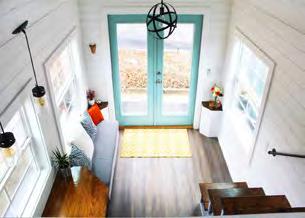



Interestingly, the builders of tiny houses do not always live in tiny houses themselves. Zach Griffin from Tiny House Nation has a tiny house for that he built for skiing (as he is a professional skier), however, his co-host John Weisbarth who helps prepare people for tiny living has never lived in one himself.8, 37 So what motivates those who do actually make the tiny move? Tiny house dwellers of all ages often share a common sentiment of wanting to simplify life in order to have time to dedicate to what’s important such as more time with family, less time cleaning house, or more time pursuing a passion-driven career, rather than working 80 hours a week at a thankless corporate job.43 Tiny houses also enable many more people to become home owners due to a much lower price tag, the average cost of a house in the US is $290,000 whereas the average cost of a tiny house is $40,000—depending on how much of the house is DIY can make it higher or lower.43 With that price tag and the benefits of voluntary simplicity* people of all stages of life are going tiny.



Voluntary simplicity in the tiny house supports a shift from obsessive consumption to resting in fulfilling personal values
The ‘voluntary simplicity’* that tiny house dwellers opt into brings a natural rearrangement of life goals and priorities while cultivating gratefulness for what we already have. Nothing not worth caring about fits in a tiny house. Yet, once again, the individual does not necessarily have to look at the larger system or how their lifestyle effects their community, the global populace, and the planet. This observation is not meant to discount the hopes, creations, and contributions these ‘early adopters’ of eco and intentional lifestyles.29 Far from it. Theses ‘creative communities’ have sparked a reexamination of our society’s values.17 Without these pioneers that have inspired thousands of Instagram posts and magazine spreads, and many conversations at city council meetings, there would not be an opportunity to use tiny houses as the subject for a book.
Tiny house dwellers have worked at the highest level of enacting change—paradigms*—revealing our assumptions and world view of what a home should and can be.20 Yet, there is room to scale positive impact through acknowledging the individual and family system’s nested role as represented in the Tiny Nested Systems diagram. Voluntary simplicity* and the shifting of goals and priorities within our tiny house, can begin to open the door to thinking in systems. The next step is shifting from seeking personal wellness to also seeking global wellness.
One aspect of tiny houses that is often overlooked is the context, influence on, and influence of tiny houses. In this book, we are looking at tiny houses (and living spaces more generally) as a system that is nested and dependent on other larger systems.
For ease of discussion we will simplify these systems into the Tiny House Nested Systems diagram on the next page. When viewed within their contexts, each aspect of the tiny house system reveals new prestige and responsibility in their interconnected roles.
The tiny house is at the center and surrounded by two characters that have the most initial direct influence over the tiny house system: the builder and the resident(s).
The house, builder, and residents are not alone but nested in and surrounded by local and global communities. The communities reside within the natural world.
How does your community rely on the natural environment you live in? For Example...
My family depends on the air being clean enough to breath in our city. My country depends on getting enough rain to fill our reservoir.
Before explore the implications of viewing tiny houses as a system, let’s address the elephant in the room. There are dozens of tiny books focused on the house itself and some about the community, and this book may not be the glossy spread of Cabin Porn you were hoping for (yes, that is a real book). However, few, if any, tiny house books explicitly discuss tiny houses in the context of societal systems, let alone, the planet’s systems. Quite often tiny house books describe building techniques, arguments for going tiny, and tried and true adaptations for this new lifestyle. Understandably, many blogs, magazines, and books tout tiny living as good for the environment or ‘sustainable,’* yet without much appreciation for unintended consequences of a simplistic focus on ‘tiny’ and without thought for the potential that tiny has for systemic change.14, 41
The fact is, humans have depleted our planet’s resources and the planet has reached it’s carrying capacity for humans given how many resources we consume.2, 21, 35 The gap between the wealthy and the poor is now a chasm.2, 32, 35 Existing economies have not lead to personal happiness, equality, or freedom from oppression. Freedom from abuse is just as important as freedom to express and achieve, yet we have too often held one over the other.27 From the smallest family system to the global community, the world needs agency* in creating wellbeing that is culturally relevant and provides for the human rights and needs of all people.27 Yet, we are still measuring success through GNP (Gross National Product)*—that rewards acts of war and natural disasters through measuring the creation of new things, rather than the actual wellbeing* of people— instead of indicators like the GPI (Genuine Progress Indicator)*—that rewards all citizens These issues are
not separate, but both factors of the same system structure.28, 32, 35 In short, the world is in ‘overshoot’.2, 21, 35 The rapid unequal consumption of products in the ‘developed’ countries has caused devastation to the homelands of citizens of other nations while providing more ‘success to the successful’ at home and ever-widening the divide between those who have all their needs met and those who barely scrap by.2, 19, 20, 35, 40 We have exceeded two to four of the nine ‘planetary boundaries’* that mark Earth’s turn from a pleasant and habitable space for people to a chaotic harsh environment with increased likelihood of frequent natural disasters.25 Arguably, we are already beginning to experience these effects globally, and most devastatingly with those who already did not have enough.7, 30
With this bleak reality that we spend hours on Twitter avoiding and then raging against—in cyclical fashion, we turn to tiny houses as a system within system to learn how to find a ‘just and safe space’ for humanity.25
In the book, Doughnut Economics: 7 Ways to think like a 21st century economist, Kate Raworth, gives us a recipe for such a space. ‘The doughnut’ is the ideal space for a thriving human species (and yes it is the land of sprinkles).25 To find the promise land, we must role-back the areas of environmental overshoot, and grow the progress towards fulfilling all basic human needs.25
On the next page, you will find a simplified version of Raworth’s doughnut. The inner boundary of The Doughnut is the base goal that allows all of humanity to be provided for.25 The outer boundary is the limit we should not exceed as it leads to climatic chaos.25
Of course, Raworth goes into much more detail about reshaping the economic system to support the changes needed to bring us into the delicious doughnut space, but what is a tiny house dweller to do? How can tiny houses help build resilience* for the human species with environmental disaster knocking at the door? The directed responses, real life illustrations, and suggestions this book offers a path to co-creation for a better individual and collective future.
Reclaimed and natural materials reduce resource use and environmental toxicity to slow overshoot and climate change
Environmental thresholds that humans should not exceed in order to maintain a habitable climate
The Doughnut
A ‘safe and just’ space for humanity
The elements of social justice (equality, peace, basic physical needs, agency)
Image Credit: recreation of ‘The Doughnut’ from Kate Raworth’s
Economics: 7 ways to think like a 21st century economist
If you were building a tiny house, what is one thing you could incorporate in the design to give back to that neighborhood community system?
If overconsumption is the primary issue, then why isn’t focusing on living tiny (smaller house, less stuff) enough? Let’s look at potential pitfalls for an exclusive focus on tiny. Conventional materials are often used in a tiny houses, such as new lumber (even when not required by code), spray foam insulation, and PVC carpets (just to name a few). Of course, the resource use and waste when building conventionally with conventional materials in a tiny house is a fraction of what is used and wasted in conventional home. Yet, these materials still contribute to the depletion of natural resources such as forests and the depletion and pollution from fossil fuels (such as petroleum/oil that create plastics). Additionally, these materials contribute to a ‘linear economy ’* where waste is not reused and end of product life pollution (often from landfills) is not considered.25 In order to solve our overconsumption issues, we will need not only consume less but more thoughtfully, creating as close to a ‘circular economy’* with very little new resource use and virtually no waste.
Careful consideration of material supply chains and lifecycles can also help avoid social issues. With conventional materials and ignoring supply chains, we miss out on the opportunity to contribute to creating a better life for our local and global neighbors as well as ourselves. Imported materials could come from factories with poor working conditions and grotesquely low wages. Local salespeople could be paid less than minimum wage with no breaks, depending on the loop holes in state labor laws. Our house guests and each night as we sleep breath in
toxic VOCs* that our paints, carpets, and adhesives leach into the air, slowly deteriorating health. Without transparency in the supply chain of materials are labor used to build the house, information does not ‘flow’ and unintended consequences abound.14, 20
Finally, just because there is tiny, does not mean overconsumption is overcome. Tiny can feed overconsumption by fooling the resident into thinking they are doing so much good, they can justify their wasteful food habits or take hot showers that last an hour—guilt-free—a phenomena known as the ‘rebound effect’* 20, 41 Additionally, because of the lower resources and lower costs, some people decided to build tiny homes as second homes, which is only consuming less than if they would have had a large second home had they not gone tiny. Moreover, tiny houses as a trend can end up causing the build of tiny houses that will never be lived in or frequently used, creating an unnecessary resource loss either because the build was not finished, did not end up meeting the dweller’s needs, or simply became an unused or short-lived vacation home.
Tiny allows for better tracking of material possessions and their impact, so information can flow, giving feed-back for building sustainable systems
Conventional Materials: Use up resources
Pollute
Create waste
Linear Economy: (What we have)


Reliant on raw materials
Everything becomes waste
Social Issues:
Inhabitant impacts
Local labor
Global inequity
Circular Economy: (What we need)
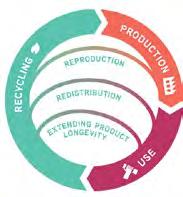

Virtually no raw resources
Nothing wasted
Feeding Over-Consumption:
Tiny Vacation homes
The ‘Rebound effect’
Tiny trends
If these pitfalls are not enough to demonstrate the need for systems thinking*, look briefly to the business case. With a rapid decrease in resource availability and an increase in consumption, the planet is coming to a bottle neck.34, 38 Businesses (and individuals) who are not ready for a world with little resources will not make it trough the bottle neck.34, 38 Companies that have integrated sustainable* practices (aka ‘Purpose Driven’* and ‘Integrated companies*) and participate in the circular economy* will continue to prosper, being already in the practice of giving more than they take. 26, 34, 38 They will easily adapt as the environment and society shifts. But what is a business case? Aren’t businesses run by people, shouldn’t we be more concerned about a case for people?
Tiny houses can move as needs and climate change
The idea that a ‘business case’ should only involve an immediate monetary benefit gives power to a non-human entity that is removed from the natural human tendency of generosity and ‘enlightened self interest’* that helps make society livable.12 As mentioned earlier, with the GPI* even our economy is slowly shifting to a model that serves us.25, 28 The system we currently have does not serve (most of) us. To be a part of the future, designers and builders have an ethical obligation to move towards a more holistic approach that incorporates sustainable* and socially just practices.14, 17, 41 When ‘tiny’ is the whole goal, we are falling far short of our potential.
Purpose-driven & Integrated Companies: Unprepared, Unadapted Companies
Best future in Era of Resource Scarcity
Tiny house designers and builders have a responsibility to aid systemic behavior change
We’ll be exploring this more in Part Two
What might be a better goal for tiny houses?
Donella Meadows, in her book, Thinking in Systems, coined the term, ‘seeking the wrong goal’* for one what she called, ‘system traps’* . 20 “One of most powerful ways to influence a system is through it’s purpose or goal.”20 If all we set out to do it build tiny or live tiny, then we are falling into the trap of ‘seeking the wrong goal’* as exemplified by the broken system (the environment in crisis and the basic needs of people not being met).20 Tiny is a poor goal that does not direct the system in the wholly better direction needed, but tiny is a great ‘leverage point’* 20 A ‘leverage point’* is the place where we put effort to change the system, and not all ‘leverage points’* are created equal.20 Some ‘leverage points’* are more effective.20 One of the most effective ‘leverage points’* is a ‘paradigm’* shift.20 Tiny houses shift paradigms*. “Paradigms are the mind-set out of which the system-its goals, structure, rules, delays, [and] parameters-arise.”20
Tiny is a paradigm shifting leverage point
Tiny houses provoke an awareness about what we find acceptable or not in our homes’ shape, size, contents, and purposes. Whether a person’s immediate reaction to tiny is rejection of the idea that they could ever live in that small of a space or whether a person spends hours browsing Pinterest and Youtube gawking over tiny house imagery and designing their
own, tiny house, tiny houses make us question what we just a second ago took for granted: our paradigm* around housing. Governments are starting to take notice of the sizable feedback tiny houses provide with cities such as Fresno, CA creating specific laws to encourage and allow tiny houses.11
If our goal is no longer tiny, what is a worthy goal? Of course it depends on what system you want to change and where the system is trapped. With Tiny houses however, what if we bring it back to The Doughnut and Tiny Nested Systems?25 Our goal for this tiny house is to create a safe and just space for the inhabitants, their communities, and the planet. The sub-goals can flow out from this higher level goal. What does safe and just look like between the builder and the dweller? Between a sister and a brother? Housemates? Partners?
Tiny is feedback to governments, companies, and society about our priorities and goals
Where do you rest your good intentions? with family? in volunteering? the environment?
Once, your paradigm* is shifted along with your goals, the work has just begun. The good intention of your new systems paradigm* doesn’t prevent negative consequences on the rest of the system. Just because you want to change the system, doesn’t mean you are creating positive effects. In order to make a difference, you have to know the effects of your actions.
The role of tiny home designers and builders is to find ways to build tiny in a way that supports and doesn’t steal from the system. Being less bad is not the same as being good. Tiny home designers and builders are uniquely positioned to work on certain leverage points*. First off, how you talk about the idea of tiny effects people’s paradigms*. Next, how you design or build tiny can either contribute to the new world or fall into system traps or create irreversible consequences for your clients or along your supply chains. Context matters. Material matters. Shape matters. “A building that is poorly sited, badly constructed, and inefficient in its use of resources cannot be redeemed by the purest of intentions.”41
You can shape your client’s behavior and expectations for welling with what you design and build.17 You can keep your clients happy long term by taking the time to get to know their values and routines as you build for them. Co-envision a lasting space. In Part Two we explore a few of the multitude of ways to help design give more back to your clients and the system than it takes.
As a designer or builder you can also help encourage governmental change (a high level community system) through zoning and codes. Advocating for your clients ability to live tiny and helping them navigate
the legality of tiny living is an important way to build the movement and grow security. Become a part of the feedback loop of democracy, guiding our institutions on how to guide society.2, 20 You can never plan for all possibilities; conversely, you will likely not avoid any unintended consequences if you don’t look for them. Every effort made to consider each building material and each storage space in the context of the tiny nested systems, lifts up the system’s (protective) roof with stability, encouraging further adaptation, resilience* , and behavior change from self-preserving to generous.
There is a lot the individual builder, designer, or individual can do, and in Part Two we look at the benefits of leading by example. However, working towards systems changing goals is utterly pointless if we work alone (no matter how beautiful our off-grid, tiny house in the woods far from town is). We must look at our past goals at all levels of community from the neighborhood to international organizations to find our just and safe space in the doughnut.25 We simply cannot do that alone. We cannot simply provide for ourselves; we are all interdependent, so we must design our system to be generous in our ‘planetary household’.25
All sustainability efforts in tiny raise up the protective roof of systemic behavior change
My neighbors made a plan to help pick up each other’s kids from school in an emergency.
My country voted to provide healthcare for everyone.
My city offered a training on bay-friendly landscaping practices.
In reality, we are communities, nested in environmental systems with infinite overlaps and interconnectivity even within our own cultures, political boundaries, families, social networks, alliances, and other human constructions.
When designers, builders, and dwellers draw on their communities, they become ‘self-organizing’ which is a powerful ‘leverage point’* 20 Tiny is already shifting paradigms*, making tiny builders and dwellers primed for a system shift.
However, the burden to create something from scratch is not always necessary, often it is best to build upon existing efforts (of which there are many). One way to find ideas and existing or modeled avenues for systems change is by looking at the UN Sustainable Development Goals (SDGs*).40 These are a list of 17 goals created by the United Nations in order to achieve global sustainable* equity by 2030.40 The goals are both comprehensive and complete, encompassing everything from renewable energy to gender equity.40 The 2030 goals is ambitious but we are dealing with an ambitious problem.40
Living tiny allows for more collaboration and sharing that facilitates global equity
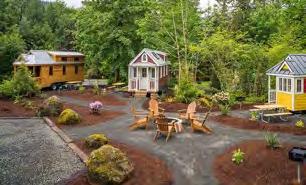
beyond the focus of the individual, collective power is building.Icon Credit: photo from Mt. Hood Tiny House Village
Show this diagram to someone who would appreciate it in the next two days.
What kind of future you want to help create, and how the thinking in terms of nested systems get you there?
All sustainability efforts in tiny raise up the protective roof of systemic behavior change
Tiny houses can move as needs and climate change
Today, we examine the goals of the tiny house to begin reworking the systems in our grasp and as a metaphor for the larger systems that humans are shifting. This tiny house metaphor can be used as a self-check-list for keeping your systems moving in a healthy direction whether at the individual, structural, community (local or global), or environmental level.
Tiny is feedback to governments, companies, and society about our priorities and goals
Windows of Transparency
Tiny allows for better tracking of material possessions and their impact as there is less to track, so information can flow and feed-back
Reclaimed and natural materials reduce resource use and environmental toxicity to slow overshoot and climate change effects
Living tiny allows for more collaboration and sharing that facilitates global equity
Voluntary simplicity in tiny supports a shift from obsessive consumption to resting in fulfilling personal values
Tiny house designers and builders have a responsibility to aid systemic behavior change
Tiny is a paradigm shifting leverage point
Will this new tiny house be resilient* as the climate changes? Will it be adaptive to the dwellers needs? How is this house connecting your dwellers to the larger community?
Will you join the new system by committing to one act of rebuilding systems?
(Part two will help you discover what that is)